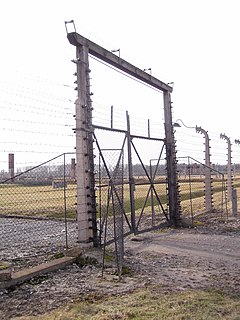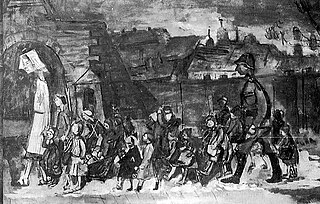 W
WTheresienstadt was a hybrid concentration camp and ghetto established by the SS during World War II in the fortress town Terezín, located in the Protectorate of Bohemia and Moravia. Theresienstadt served two main purposes: it was simultaneously a waystation to the extermination camps, and a "retirement settlement" for elderly and prominent Jews to mislead their communities about the Final Solution. Its conditions were deliberately engineered to hasten the death of its prisoners, and the ghetto also served a propaganda role. Unlike other ghettos, the exploitation of forced labor was not economically significant.
 W
WBeit Terezin or Beit Theresienstadt is a research and educational institution that opened in 1975 in Kibbutz Givat Haim (Ihud), a museum and a place of remembrance of the victims of Nazi Germany persecution at the Theresienstadt concentration camp.
 W
WBrundibár is a children's opera by Jewish Czech composer Hans Krása with a libretto by Adolf Hoffmeister, made most famous by performances by the children of Theresienstadt concentration camp (Terezín) in occupied Czechoslovakia. The name comes from a Czech colloquialism for a bumblebee.
 W
WTheresienstadt was originally designated as a model community for middle-class Jews from Germany, Czechoslovakia, and Austria. Many educated Jews were inmates of Theresienstadt. In a propaganda effort designed to fool the western allies, the Nazis publicised the camp for its rich cultural life. In reality, according to a Holocaust survivor, "during the early period there were no [musical] instruments whatsoever, and the cultural life came to develop itself only ... when the whole management of Theresienstadt was steered into an organized course."
 W
WFrantišek Michl, Czech academic painter, graphic artist, and original designer of the Škoda Works emblem, the "Winged Arrow". He was imprisoned in Pankrac Prison, and the concentration camps Terezin and Flossenbürg after his arrest by Nazis for an anti-fascist demonstration at Domažlice. After the war he was arrested in the Czechoslovak Socialist Republic for listening to the anticommunist Radio Liberty.
 W
WParadise Camp is a 1986 documentary film about Theresienstadt concentration camp in Czechoslovakia, written and directed by Australians Paul Rea and Frank Heimans, respectively. Czechoslovakian Jews were first told that Theresienstadt was a community established for their safety. They quickly recognized it as a ghetto and concentration camp.
 W
WOn the night of 5 April 1944, Siegfried Lederer, a Czech Jew, escaped from the Auschwitz concentration camp wearing an SS uniform provided by SS-Rottenführer Viktor Pestek. Pestek opposed the Holocaust; he was a devout Catholic and was infatuated with Renée Neumann, a Jewish prisoner. He accompanied Lederer out of the camp, and the two men traveled together to the Protectorate of Bohemia and Moravia to obtain false documents for Neumann and her mother.
 W
WTerezín: The Music 1941–44 is a 2-CD set with music written by inmates at the Terezín concentration camp during World War II.
 W
WTheresienstadt. Ein Dokumentarfilm aus dem jüdischen Siedlungsgebiet, unofficially Der Führer schenkt den Juden eine Stadt, was a black-and-white projected Nazi propaganda film. It was directed by the German Jewish prisoner Kurt Gerron and the Czech filmmaker Karel Pečený under close SS supervision in the Theresienstadt concentration camp, and edited by Pečený's company, Aktualita. Filmed mostly in the autumn of 1944, it was completed on 28 March 1945 and screened privately four times. After the war, the film was lost but about twenty minutes of footage was later rediscovered in various archives.
 W
WThe Theresienstadt family camp, also known as the Czech family camp, consisted of a group of Jewish inmates from the Theresienstadt ghetto in Czechoslovakia, who were held in the BIIb section of the Auschwitz II-Birkenau concentration camp from 8 September 1943 to 12 July 1944. The Germans created the camp to mislead the outside world about the Final Solution.
 W
WThe Theresienstadt Papers are a collection of historical documents of the Jewish self-government of Theresienstadt concentration camp. These papers include an "A list" of so-called "prominents" interned in the camp and a "B-list" created by the Jewish Elders themselves. The Theresienstadt papers include two albums with biographies and many photographs, 64 watercolors and drawings from prisoners in Theresiendstadt, and the annual report of the Theresienstadt Central Library. The papers were preserved at the liberation of the camp in May 1945 by Theresienstadt librarian Käthe Starke-Goldschmidt and later loaned to the Altona Museum for Art and Cultural History in Hamburg by her son Pit Goldschmidt. The collection was opened for viewing by the public in 2002 at the Heine Haus branch of the Altona Museum.
 W
WOn 21 August 1943, during the liquidation of the Białystok Ghetto, about 1,200 Jewish children were put on trains and taken to Theresienstadt concentration camp, where they were held in isolation from other prisoners. On 5 October, they were told that they would be sent to Switzerland in exchange for German prisoners of war. Instead, the train went to Auschwitz concentration camp where all were murdered in gas chambers. The reason for the unusual route of the transport is still debated by scholars; it is believed to be connected to Nazi–Jewish negotiations ongoing at the time and the intervention of Mohammad Amin al-Husseini, who feared that the children would settle in Palestine.
 W
WUniversity over the Abyss is a book about the educational and cultural life in the Terezín ghetto. Authors Elena Makarova, Sergei Makarov and Viktor Kuperman have searched available archives, interviewed survivors worldwide and compiled the definitive summary of this nominally illegal but extensive phenomenon that included formal lectures, poetry readings, concerts, storytelling sessions and theatrical and opera performances, all in a setting that was a holding place for prisoners who were ultimately on their way to the Auschwitz-Birkenau extermination camp.
 W
W W
W W
W